Monograms go in and out of style. For some it's not a wedding if there isn't a new monogram to celebrate the union. Two-letter. Three-letter. Script or block fonts. On the dance floor. On the cake. Embroidered onto a wedding dress and engraved onto invitations. For others, monograms are the utmost symbol of all that is passé, the polar opposite of what their wedding is all about.
Sometimes, the very existence of a monogram holds a point in time, memorializing it forever. The two monograms in this photo are precious to me. The first, AGJ, belonged to my mother's mother, my grandmother. She was the original Hannah who changed her name to Anne because it sounded more young and modern. AGJ was her married monogram, and she had it crafted into an Art Deco brooch. We have pictures of her wearing it back in the 1940s.
And indeed, Anne remains forever young—she died of breast cancer at the age of 36, when my mother was just five years old. Her loss was the defining moment of my mother's life, and as I was her first born, I was given the honor of carrying the name forward. I wear it proudly. Sometimes, on special occasions or for an important meeting, I take out the brooch and put it on. It feels good to wear it.
The second brooch in the photo, MFD, belonged to Anne's sister, Mimi. She was my mother's aunt, and the one who raised her. Mimi was the one I knew as my grandmother, the kind-to-her-core, loving and good-hearted woman who scooped up my mother in her loss and grief and made her life as good and whole as she could.
Monograms aren't just pretty graphics to add visual interest—sometimes they hold deeper meaning. Styles come and go, but the stories behind them live on.



